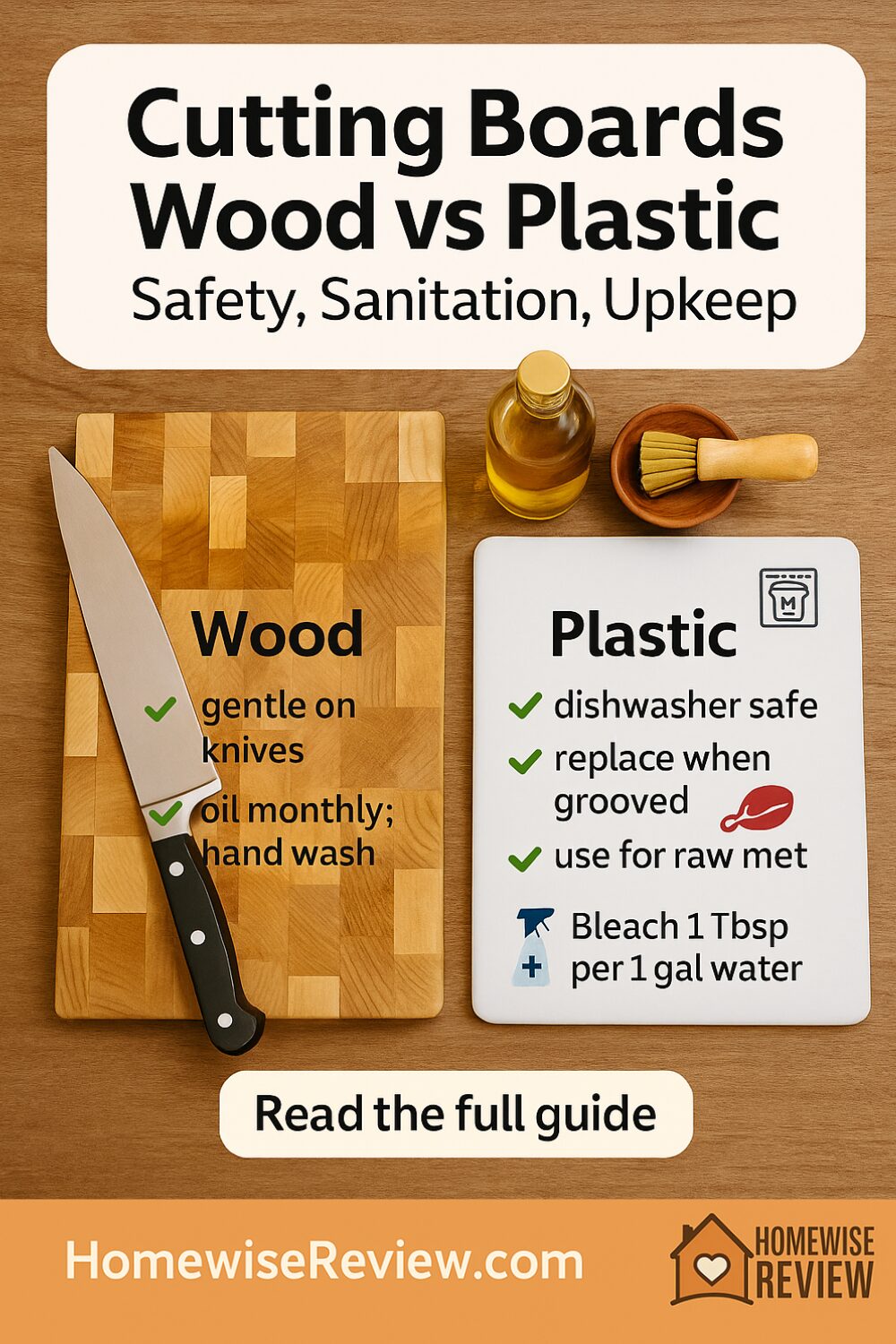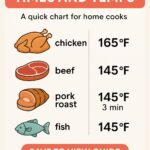
Who this is for: Home cooks who want a safer prep zone, knives that stay sharp, and boards that last.
Bottom line: Wood is gentle on knives and naturally resilient when cared for. Plastic is affordable, color coded, and dishwasher safe. The safest kitchen uses both, with clear jobs and simple cleaning habits.
Quick comparison
| Board type | Best uses | Pros | Watch outs |
|---|---|---|---|
| End-grain wood (maple, walnut) | Daily prep, chopping, carving | Gentle on knives, self-healing surface, looks great | Hand wash only, needs oiling, heavier and pricier |
| Edge-grain wood (maple, walnut, cherry) | Everyday slicing and dicing | Lighter and cheaper than end-grain, kinder to knives than plastic | Shows grooves sooner, still needs oiling |
| Bamboo | Veg and fruit prep, light duty | Budget friendly, stable, low water uptake | Harder on knife edges, often glued strips, still hand wash |
| Plastic (HDPE or PP) | Raw meat and fish, color coded tasks | Dishwasher safe, light, cheap to replace, great for camping | Knife scars hold residue, can warp, looks tired fast |
Safety first: the case for using both
Cross-contamination is the real risk, not the board material by itself. Owners who keep a dedicated plastic board for raw proteins and a wood board for produce report fewer what-if moments at cleanup. Color coding helps. Red for meat. Green for veg. Blue for fish. White for bakery or dairy. If your set is not colored, write on the edges with a permanent marker.
Knife safety matters too. End-grain wood feels “springy” under the blade, which protects edges and gives you more control on fast chops. Plastic can feel slick when wet. If you prep lots of tomatoes, onions, and herbs, a heavy wooden board that does not skate around reduces accidents.
Sanitation routines that work
Daily clean, no drama
- Wood: Scrape crumbs with a bench scraper. Wash with warm water and a drop of dish soap. Wipe both sides so moisture stays even. Rinse quickly. Stand on edge to air dry.
- Plastic: Same as wood or place on the top rack of the dishwasher. Let it dry fully so grooves do not stay damp.
When you handled raw protein
- Plastic: Run through the dishwasher on a hot cycle. If washing by hand, scrub with hot soapy water, rinse, then sanitize with a mild bleach solution. Let air dry upright.
- Wood: Wash promptly with hot soapy water. Rinse, then sanitize lightly. Many owners use a diluted bleach solution followed by a clean water rinse. Dry on edge. Do not soak and do not leave it flat in a puddle.
Quick, practical sanitizing options
Pick one and use it correctly. Always finish with a clean water rinse on both wood and plastic, then air dry.
- Diluted bleach: 1 tablespoon unscented bleach in 1 gallon of water. Wipe, wait 1 minute, rinse.
- 3 percent hydrogen peroxide: Flood, wait 1 minute, rinse.
- White vinegar: Wipe to reduce odors. Better as an odor step than a stand-alone sanitizer.
Pro tip: Sanitizing works only on a clean surface. Soap first. Sanitizer second. Dry last.
Wood upkeep that keeps boards beautiful
Oil on a schedule. Mineral oil or board oil keeps fibers from drying and cracking. For busy kitchens, owners find that once a month is the sweet spot. If your board looks pale or drinks water fast, it needs oil.
How to oil, step by step
- Start with a clean, fully dry board.
- Pour a tablespoon of food-grade mineral oil and rub with a lint-free cloth over all sides and the edges.
- Let it soak for 20 to 30 minutes. Wipe off extra.
- For bonus water resistance, finish with a board cream made of mineral oil plus beeswax.
De-stink and refresh
- Sprinkle coarse salt and scrub with half a lemon. Rinse and dry.
- For onion and garlic odors, a baking soda paste works well. Rinse and dry, then oil if the surface looks thirsty.
Repair shallow scars
- Sand lightly with fine paper in the direction of the grain. Wipe dust. Re-oil. Deep splits or lifting glue lines mean it is time to replace.
Plastic board realities
Dishwasher safe is the win. That is why plastic boards shine for raw chicken night. Heat plus detergent plus spray action clears proteins tucked into knife scars.
But scars add up. When the surface looks fuzzy, grooves hold residue, or the board never smells “clean” after washing, retire it. Owners who replace raw-protein boards yearly avoid frustration and play it safe.
Keep them flat. Thin boards warp on the lower rack. Use top rack only. Lay the board flat to cool after the cycle so it does not bow.
Knife edge and board hardness
- End-grain wood has fibers that part and then close, which is why it feels kind to edges and shows fewer deep cuts.
- Edge-grain wood is still friendly but will show grooves sooner.
- Bamboo is harder and sometimes contains silica. It can dull edges faster.
- Plastic is softer than bamboo but develops jagged cuts that drag on the knife if you never replace it.
If you sharpen at home, wood rewards the habit with longer intervals between full sharpenings. If you send knives out, you may even save money over time by babying edges with wood.
When bigger is actually safer
Owners who upgrade to a larger, heavier wood board report fewer slips and a more relaxed prep flow. A roomy surface keeps raw and ready items separate on the same board and gives you space to stabilize the knife. If your counter is slick, park a damp dish towel or a silicone mat under any board to lock it in place.
Which wood to buy
- Maple and walnut are classics for a reason. They balance hardness and resilience.
- Teak resists water well, but the natural silica can dull knives a bit faster.
- Acacia and cherry are fine for lighter duty and look beautiful.
- End-grain vs edge-grain: End-grain lasts longer and is gentler on knives. Edge-grain is more affordable and lighter to move.
Avoid boards with lots of decorative seams, soft mystery woods, or heavy varnish. A board should be food-safe wood with a simple oilable finish.
Smarter workflow on busy nights
- Set roles: Plastic for raw proteins. Wood for produce and bread.
- Stage wipes: Keep a clean towel and a soapy sponge ready before you ever open meat packaging.
- Work clean: Move finished items to a tray. Clear scraps often so you are not juggling peels and poultry at the same time.
- End with soap, sanitize, then dry upright. Do not leave boards sprawled on the counter.
Troubleshooting
- My wood board smells after onions: Scrub with baking soda, rinse, dry, then oil. Odor lives in the top fibers and lifts with a quick refresh.
- My plastic board is slimy after the dishwasher: It is time to replace. Those grooves are past saving.
- My board is cupping or bowing: You may be wetting one side more than the other. Wash both sides quickly, dry on edge, and oil both faces to rebalance.
- I see black spots on wood: That can be mildew from staying damp. Sand the area, clean, dry thoroughly, and oil. If spots spread or smell persists, retire the board.
Final Thoughts
You do not have to pick a side. Use plastic for raw proteins so you can blast it clean in the dishwasher. Use wood for produce, herbs, carving, and bread so your knives stay sharp and your prep stays stable. Clean promptly, sanitize correctly, dry upright, and oil wood once a month. Those small habits keep your boards safer, better looking, and easier to live with for years.
See Also
If you are updating the rest of your prep gear, compare surfaces and heat limits in Best Nonstick Frying Pans: PFAS vs Ceramic so you know when to switch pans for searing vs slip. For roast nights, keep the numbers handy from Food Safety Times and Temps: Quick Chart for Home Cooks and use a thermometer for doneness instead of guessing by color.
If hard water makes cleanup feel never-ending, our How to Descale Any Coffee Maker (Vinegar vs Citric Acid) shows the same mineral logic that can leave film on boards. For everyday kitchen upkeep, the quick-hit advice in Fake Sales Warning Guide: Spot Price Tricks, Old-Stock Dumps, and Real Deals helps you avoid gimmicky board care kits, and Best Coffee Machines: Head-to-Head Showdown pairs well with a sturdy wood board on brunch days. Round out your toolkit with Stain-Rescue Decision Tree – Quick Steps and Tips so beet and berry marks on wood do not become permanent.
FAQs
Is wood really safe for meat if I sanitize it
It can be, but plastic is easier to run through a hot dishwasher after raw chicken. Most home cooks assign plastic to proteins and wood to produce to keep things simple.
What bleach ratio should I use to sanitize a board
Use a mild solution like 1 tablespoon unscented bleach in 1 gallon of water. Wipe, wait one minute, then rinse with clean water and air dry upright.
How often should I oil a wood board
About once a month for most kitchens. If the surface looks pale or absorbs water instantly, oil it sooner.
When do I replace a plastic board
When grooves are deep and fuzzy, odors linger after cleaning, or the surface looks permanently stained or warped. Thin boards are cheap to replace. Do it without guilt.
End-grain or edge-grain for my first wood board
If budget allows, end-grain is kinder to knives and wears longer. Edge-grain is lighter and more affordable and still a big upgrade over plastic for daily chopping.
Affiliate Disclosure
If you purchase through links on our site, we may earn a small commission at no extra cost to you.




